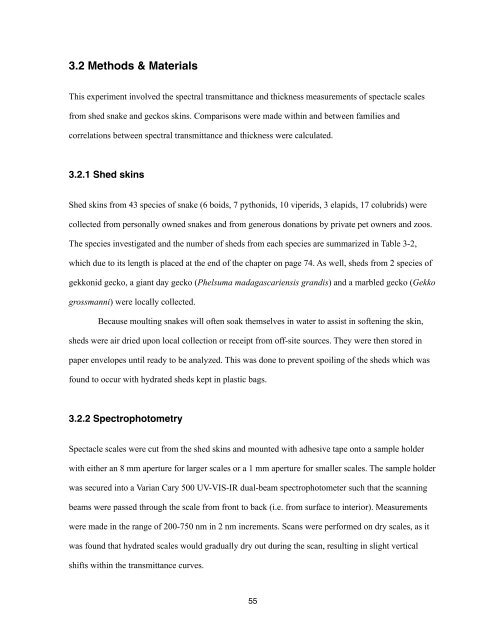Chapter 1, The Reptilian Spectacle - UWSpace - University of ...
Chapter 1, The Reptilian Spectacle - UWSpace - University of ...
Chapter 1, The Reptilian Spectacle - UWSpace - University of ...
Create successful ePaper yourself
Turn your PDF publications into a flip-book with our unique Google optimized e-Paper software.
3.2 Methods & Materials<br />
This experiment involved the spectral transmittance and thickness measurements <strong>of</strong> spectacle scales<br />
from shed snake and geckos skins. Comparisons were made within and between families and<br />
correlations between spectral transmittance and thickness were calculated.<br />
3.2.1 Shed skins<br />
Shed skins from 43 species <strong>of</strong> snake (6 boids, 7 pythonids, 10 viperids, 3 elapids, 17 colubrids) were<br />
collected from personally owned snakes and from generous donations by private pet owners and zoos.<br />
<strong>The</strong> species investigated and the number <strong>of</strong> sheds from each species are summarized in Table 3-2,<br />
which due to its length is placed at the end <strong>of</strong> the chapter on page 74. As well, sheds from 2 species <strong>of</strong><br />
gekkonid gecko, a giant day gecko (Phelsuma madagascariensis grandis) and a marbled gecko (Gekko<br />
grossmanni) were locally collected.<br />
Because moulting snakes will <strong>of</strong>ten soak themselves in water to assist in s<strong>of</strong>tening the skin,<br />
sheds were air dried upon local collection or receipt from <strong>of</strong>f-site sources. <strong>The</strong>y were then stored in<br />
paper envelopes until ready to be analyzed. This was done to prevent spoiling <strong>of</strong> the sheds which was<br />
found to occur with hydrated sheds kept in plastic bags.<br />
3.2.2 Spectrophotometry<br />
<strong>Spectacle</strong> scales were cut from the shed skins and mounted with adhesive tape onto a sample holder<br />
with either an 8 mm aperture for larger scales or a 1 mm aperture for smaller scales. <strong>The</strong> sample holder<br />
was secured into a Varian Cary 500 UV-VIS-IR dual-beam spectrophotometer such that the scanning<br />
beams were passed through the scale from front to back (i.e. from surface to interior). Measurements<br />
were made in the range <strong>of</strong> 200-750 nm in 2 nm increments. Scans were performed on dry scales, as it<br />
was found that hydrated scales would gradually dry out during the scan, resulting in slight vertical<br />
shifts within the transmittance curves.<br />
55
















